Dynamic Response Analysis of Soil around Curve Section Tunnel under Train Vibration Load
Abstract
:1. Introduction
2. Engineering Overview and Monitoring Point Layout
3. Analysis of Pore Water Pressure Response to Vehicle-Induced Vibration Loads
3.1. Analysis of In Situ Pore Pressure Monitoring Results
3.2. Analysis of Excess Pore Water Pressure Response
3.3. Variation Patterns of Pore Pressure at Different Depths under Vibration Loads
3.4. Analysis of Groundwater Level Response
3.5. Analysis of Settlement Response
3.6. Characteristics of Soil Pore Water Pressure under Train Operation Conditions
4. Model Establishment
4.1. Establishment of Three-Dimensional Finite Element Model for Subway
4.1.1. Geometric Dimensions
4.1.2. Selection of Material Parameters
4.2. Simulation and Application of Train Vibration Loads
4.2.1. Simulation of Train Vibration Loads
4.2.2. Application of Train Vibration Loads
5. Analysis of Computational Results
5.1. Comparison between Simulation Results and Experimental Measurements
5.2. Analysis of Pore Water Pressure
5.3. Analysis of Vertical Deformation Response
5.3.1. Vertical Deformation under Different Curve Radii
5.3.2. Vertical Deformation at Different Velocities
5.4. Settlement Comparison
6. Conclusions
- During the initial stage of train operation, the pore water pressure is relatively high. However, as time passes, the pore pressure gradually decreases. Overall, there is a seasonal trend, with the weather warming up in the second quarter, the temperature rising, and rainfall reducing, leading to a significant drop in water level and pore pressure. The rate of decrease in pore pressure and water level differs depending on the depth of burial, with deeper monitoring points showing smaller changes in rate, and shallower monitoring points showing larger changes in rate;
- Under the action of train vibration load, the response of the soil surrounding the tunnel is closely related to the location, and the response becomes more sensitive the closer it is to the tunnel. After exceeding a certain depth range, the disturbance effect of train vibration on the soil gradually reduces and is more affected by changes in groundwater level and rainfall. The pore pressure in the soil is basically the same as the static water pressure at the same depth, and is proportional to the depth;
- The trend of groundwater level change in the soil is basically consistent with the trend of pore pressure change, and the groundwater level is proportional to the depth;
- Under the action of subway vibration load, the closer to the bottom of the tunnel the curves are, the greater the amplitude and rate of change of pore pressure, and the greater the vertical deformation. The vertical deformation response of the bottom soil of the small radius curve tunnel under the action of different train running speeds decreases with the increase in the distance from the tunnel and increases with the increase in the speed. The dynamic response of the soil at the bottom of the tunnel decreases with increasing depth and radius of curvature, and the main impact range of the dynamic response is 0–15 m below the bottom of the tunnel.
Author Contributions
Funding
Institutional Review Board Statement
Informed Consent Statement
Data Availability Statement
Conflicts of Interest
References
- Fan, Y.; Su, Y.; Yuan, Y.; Yao, X.P. Study on the surface subsidence law of composite formation double-line subway tunnel construction. J. Undergr. Space Eng. 2020, 16, 762–768+789. [Google Scholar]
- Zhang, B.W.; Qian, W.P.; Qi, T.Y.; Xiang, Z.R.; Wang, Y. Settlement prediction and safety control of subgrade through high-speed railway under urban subway. J. Undergr. Space Eng. 2021, 17, 282–289. [Google Scholar]
- Yao, Z.X.; Liu, Y.X.; Zhang, Z.X.; Zeng, Z.Y.; Deng, L.Z. Study on dynamic response of group tunnel under the action of overlying surface. J. Undergr. Space Eng. 2022, 18, 1363–1373. [Google Scholar]
- Zhang, X.W.; Wang, C. Analysis of surrounding rock stability and surface settlement in weak layered foundation tunnel. J. Undergr. Space Eng. 2022, 18, 396–403+411. [Google Scholar]
- Yang, W.B.; Li, L.G.; Dai, Z.R.; Xu, C.Y. Analysis of the environmental impact of shield tunnel operation in water-rich pebble land layer. J. Undergr. Space Eng. 2018, 14, 1709–1716. [Google Scholar]
- Tang, Y.Q.; Zhang, X.; Zhao, S.K.; Wang, J.X.; Zhou, N.Q. Hole pressure development model of saturated soft clay around the tunnel under subway vibration load. J. Civ. Eng. 2007, 4, 82–86. [Google Scholar]
- Tang, Y.Q.; Luan, C.Q.; Zhang, X.; Wang, J.X.; Yang, P. Numerical simulation of tunnel soil deformation under subway vibration load. J. Undergr. Space Eng. 2008, 4, 105. [Google Scholar]
- Dai, L.F.B.; Wang, G.D.; Gao, B. Study on Sand liquefaction around Tunnel. J. Undergr. Space Eng. 2012, 2, 434–438. [Google Scholar]
- Xu, Y.; Xu, J.L.; Dai, J.; Xu, C.S.; Cui, C.Y.; Meng, K. Study on pore water pressure and deformation characteristics of tunnel bottom under the vibration load of subway train. Tunn. Constr. 2018, 38, 1785–1792. [Google Scholar]
- Meng, G.; Zhang, J.X.; Wu, T.L. Numerical Simulation of Tunnel Soil formation under Subway Load. J. Tianjin Urban Constr. Coll. 2012, 18, 103. [Google Scholar]
- Lei, H.Y.; Yang, X.N.; Xu, Y.G.; Zhang, L. Dynamic property test of saturated remodeling clay under intermittent cyclic load conditions. J. Tianjin Univ. (Nat. Sci. Eng. Technol. Ed.) 2021, 54, 799–806. [Google Scholar]
- Wang, X.P.; Li, G.F.; Mu, X.L.; Wang, H.B.; Jin, Z.Y.; Ding, W.C. Dynamic response analysis of the low-speed maglev vehicle-orbit coupling system in the small radius curve. Vib. Impact 2022, 41, 81–89+105. [Google Scholar]
- Bian, X.C. Track and ground vibrations generated by high-speed train running on ballastless railway with excitation of vertical track irregularities. Soil Dyn. Earthq. Eng. 2015, 76, 29–43. [Google Scholar] [CrossRef]
- Zhou, S.; He, C.; Di, H. An efficient method for predicting train-induced vibrations from a tunnel in a poroelastic half-space. Eng. Anal. Bound. Elem. 2017, 85, 43–56. [Google Scholar] [CrossRef]
- Cary, C.E.; Zapata, C.E. Pore Water Pressure Response of Soil Subjected to Dynamic Loading under Saturated and Unsaturated Conditions. Int. J. Geomech. 2016, 16, D4016004. [Google Scholar] [CrossRef] [Green Version]
- Jones, C.J.C.; Thompson, D.J.; Petyt, M. A model for ground vibration from railway tunnels. Proc. Inst. Civ. Eng.—Transp. 2002, 153, 121–129. [Google Scholar] [CrossRef]
- Gardien, W.; Stuit, H.G. Modelling of soil vibrations from railway tunnels. J. Sound Vib. 2003, 267, 605–619. [Google Scholar] [CrossRef]
- Clouteau, D. Freefield vibrations due to dynamic loading on a tunnel embedded in a stratified medium. J. Sound Vib. 2004, 283, 173–199. [Google Scholar] [CrossRef]
- Gupta, S.; Degrande, G.; Lombaert, G. Experimental validation of a numerical model for subway induced vibrations. J. Sound Vib. 2008, 321, 786–812. [Google Scholar] [CrossRef]
- Xia, Z.Q.; Ling, K.S.; Dong, K.S. Vibration response analysis of school buildings caused by metro trains running on a curved track. China Earthq. Eng. J. 2021, 43, 1377–1386. [Google Scholar]
- Ngamkhanong, C.; Kaewunruen, S. The effect of ground borne vibrations from high speed train on overhead line equipment (OHLE) structure considering soil-structure interaction. Sci. Total Environ. 2018, 627, 934–941. [Google Scholar] [CrossRef] [PubMed] [Green Version]
- Li, T.; Su, Q.; Kaewunruen, S. Influences of dynamic material properties of slab track components on the train-track vibration interactions. Eng. Fail. Anal. 2020, 115, 104633. [Google Scholar] [CrossRef]
- Ramos, A.; Correia, A.G.; Calçada, R. Ballastless railway track transition zones: An embankment to tunnel analysis. Transp. Geotech. 2022, 33, 100728. [Google Scholar] [CrossRef]
- Yaseri, A.; Bazyar, M.H.; Hataf, N. 3D coupled scaled boundary finite-element/finite-element analysis of ground vibrations induced by underground train movement. Comput. Geotech. 2014, 60, 1–8. [Google Scholar] [CrossRef]
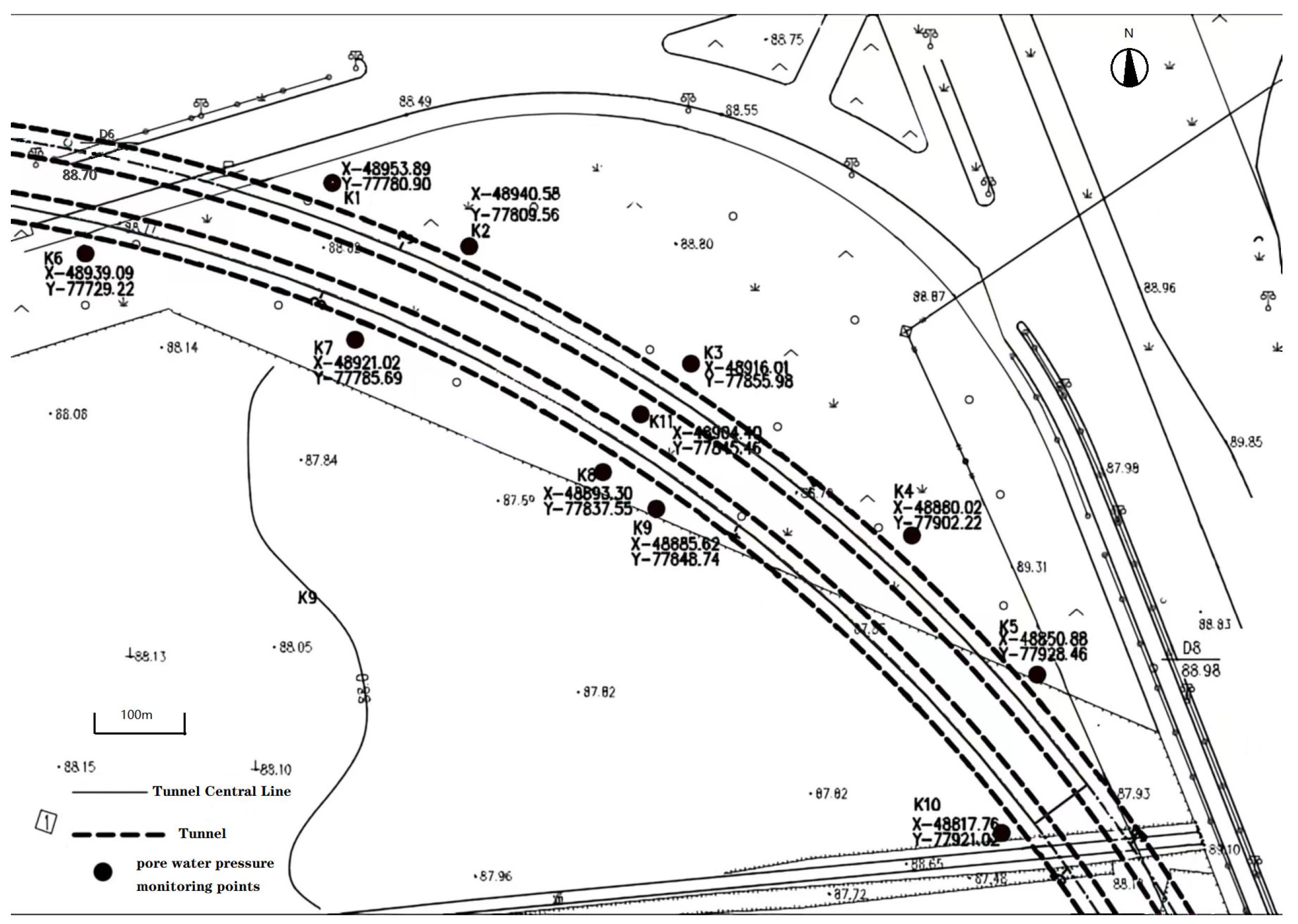

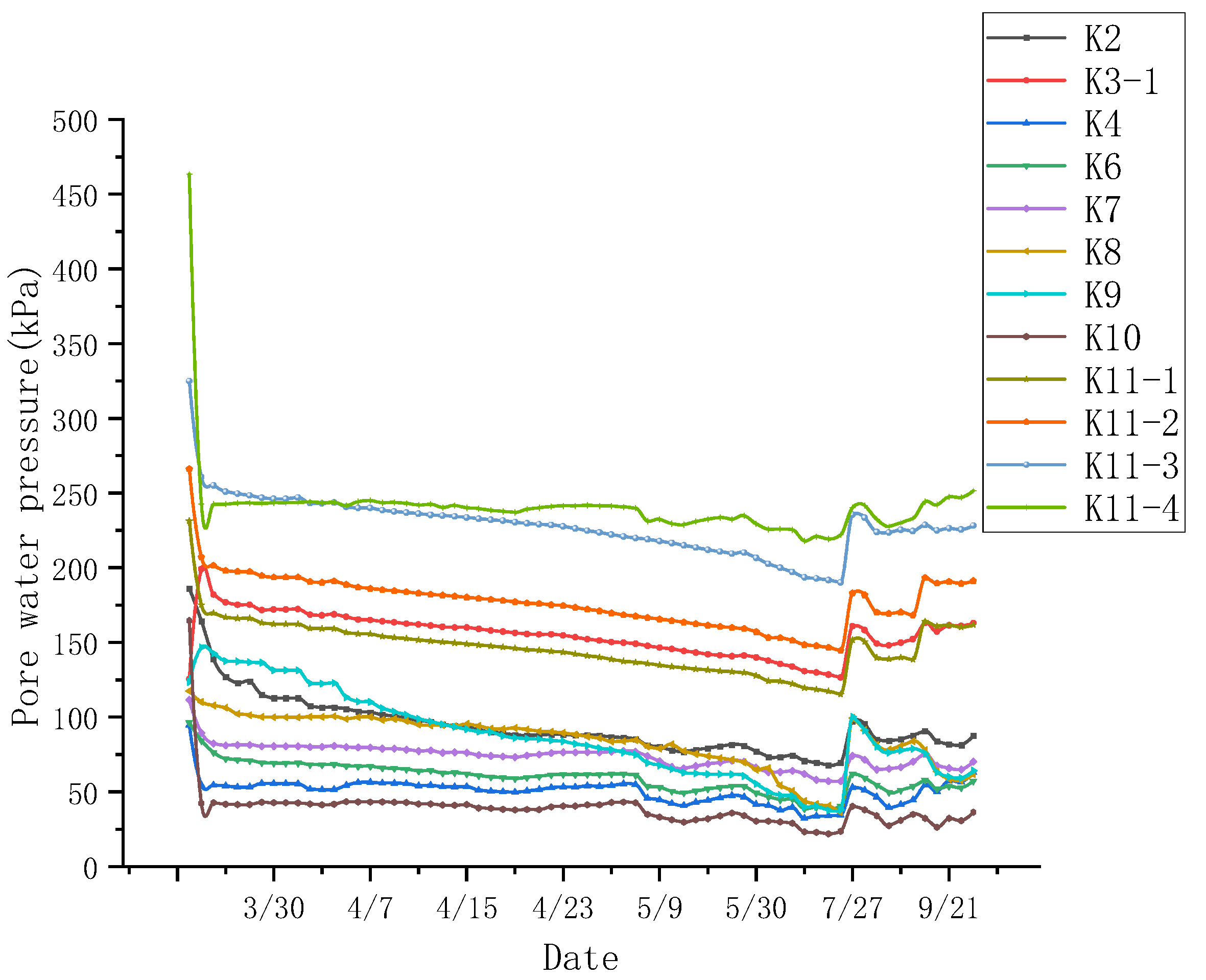
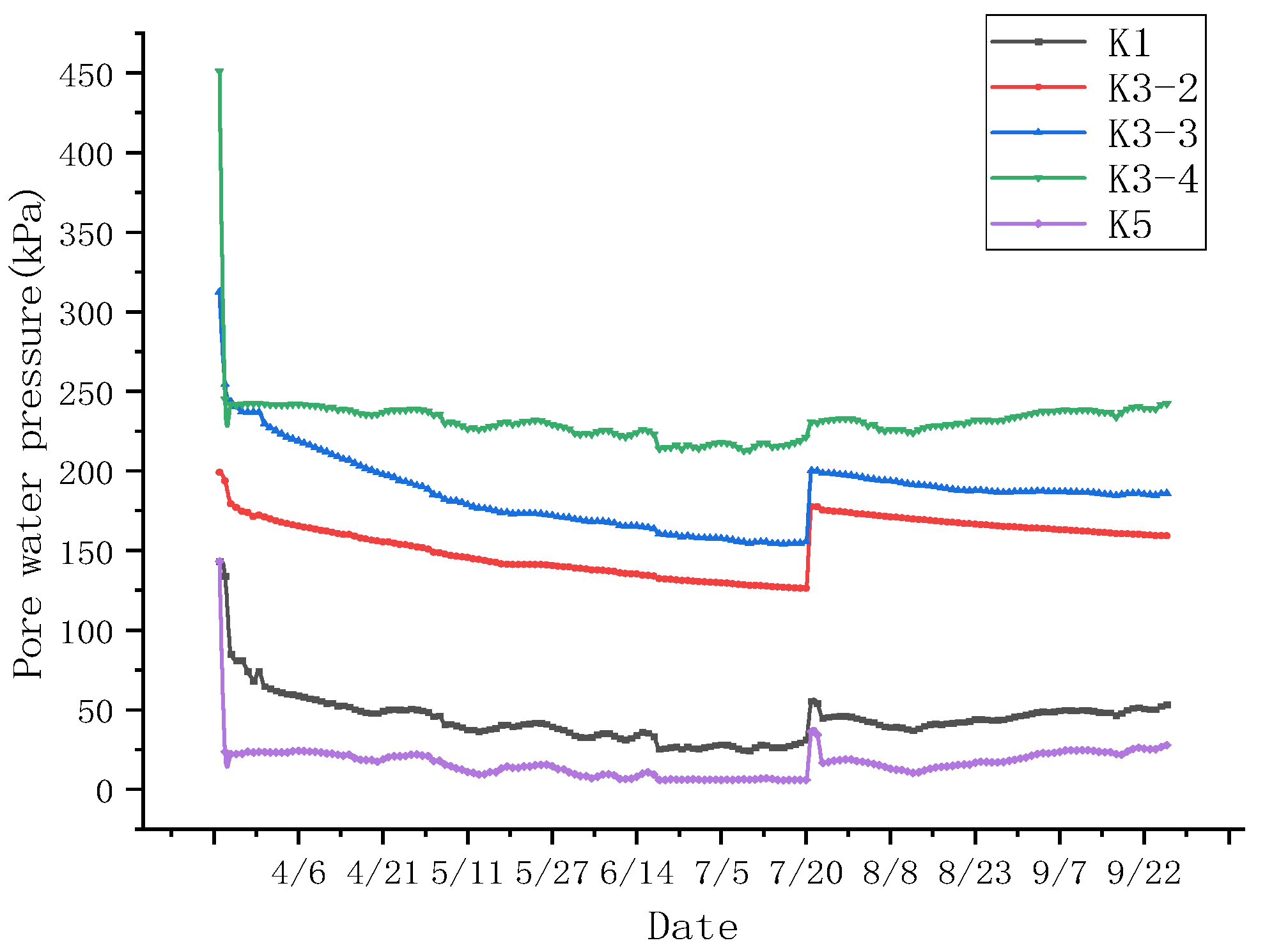
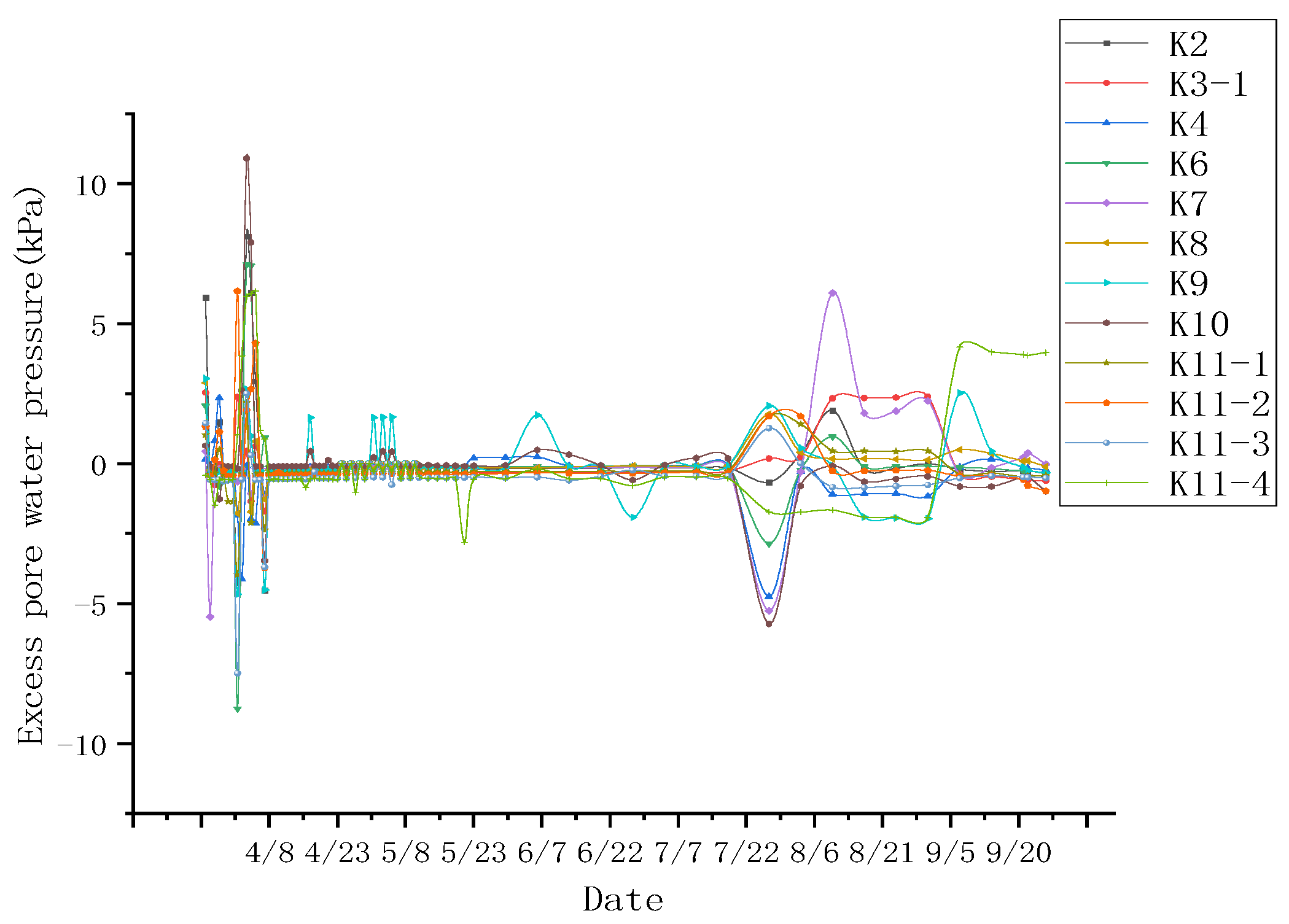

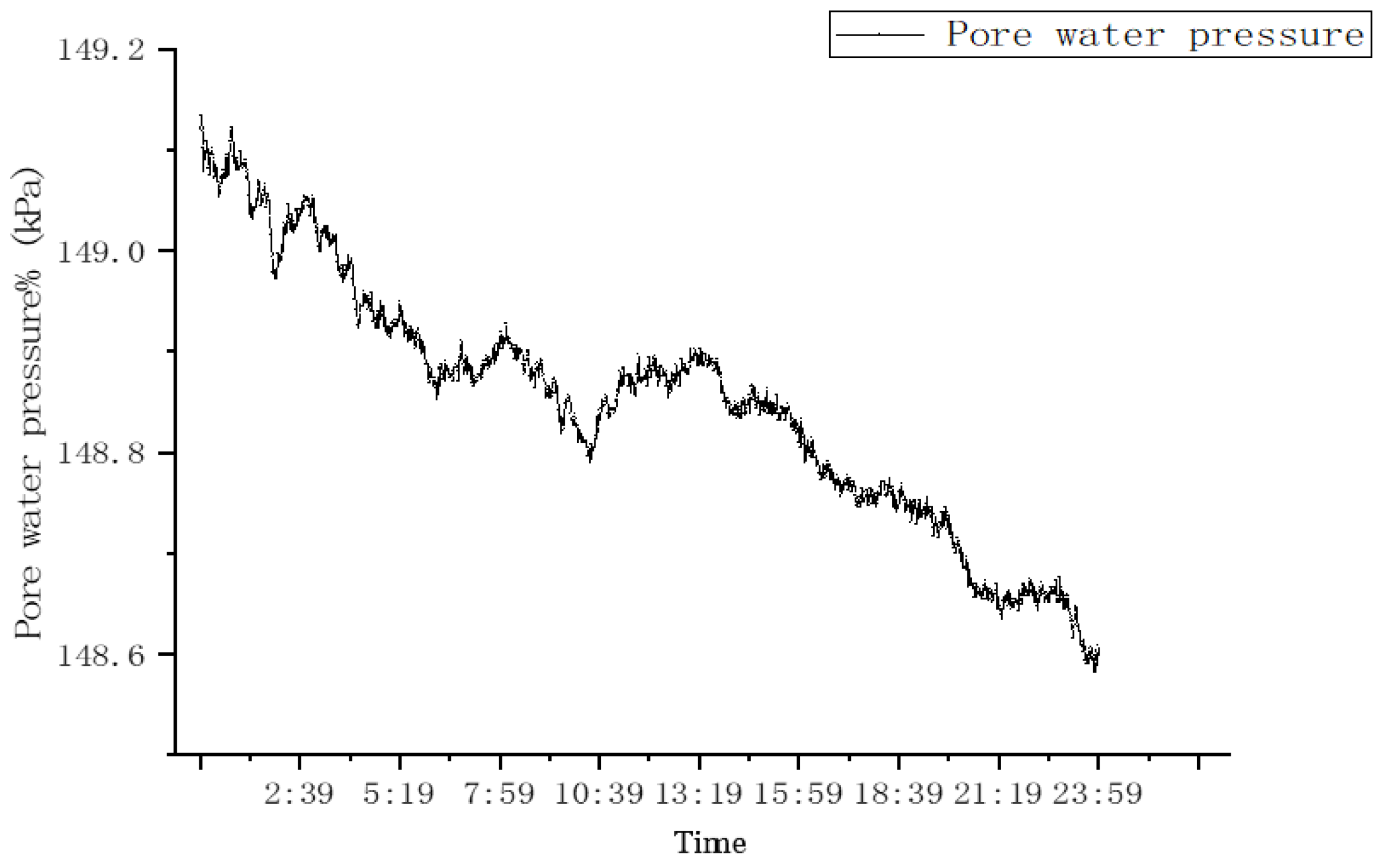
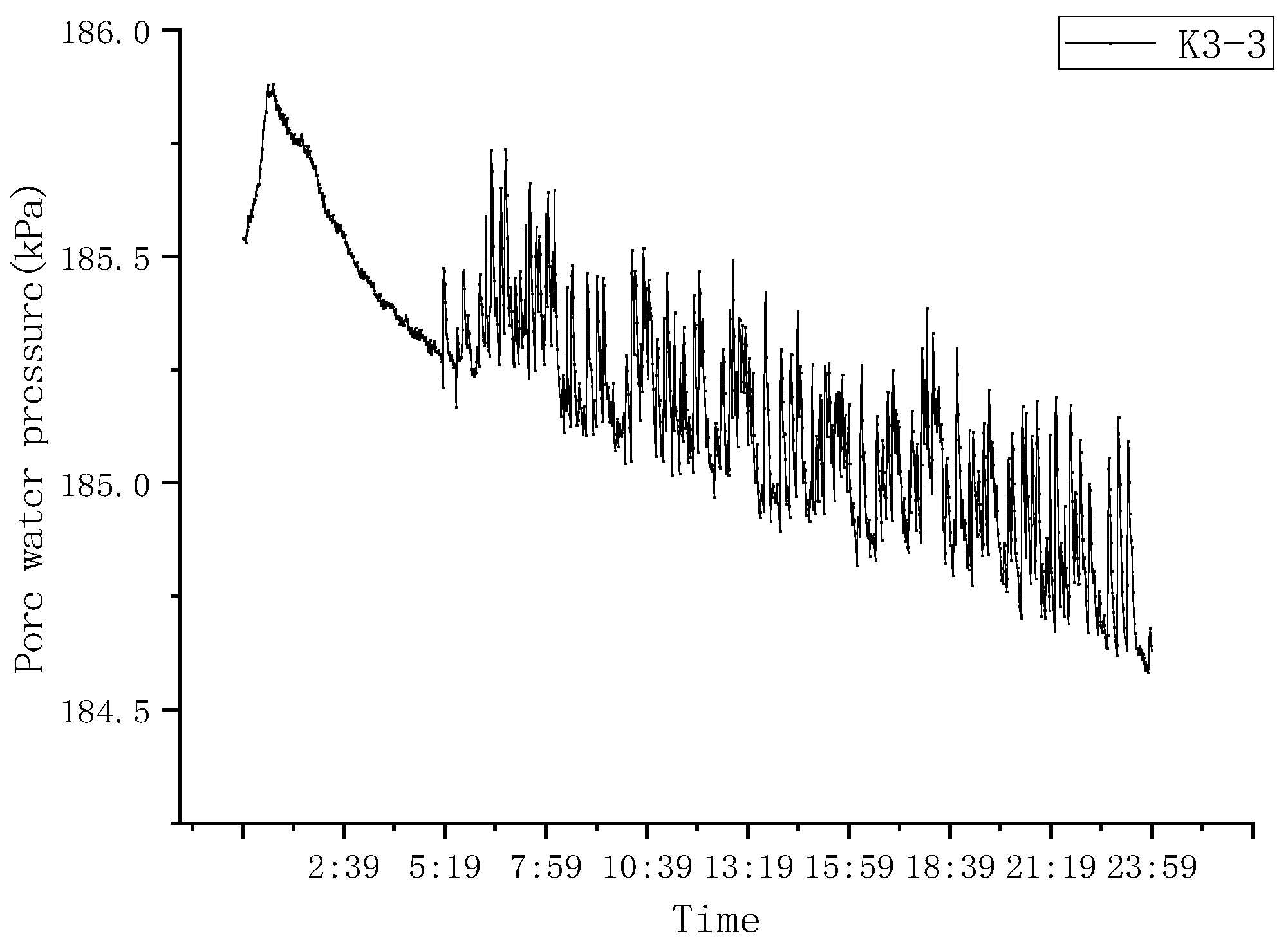
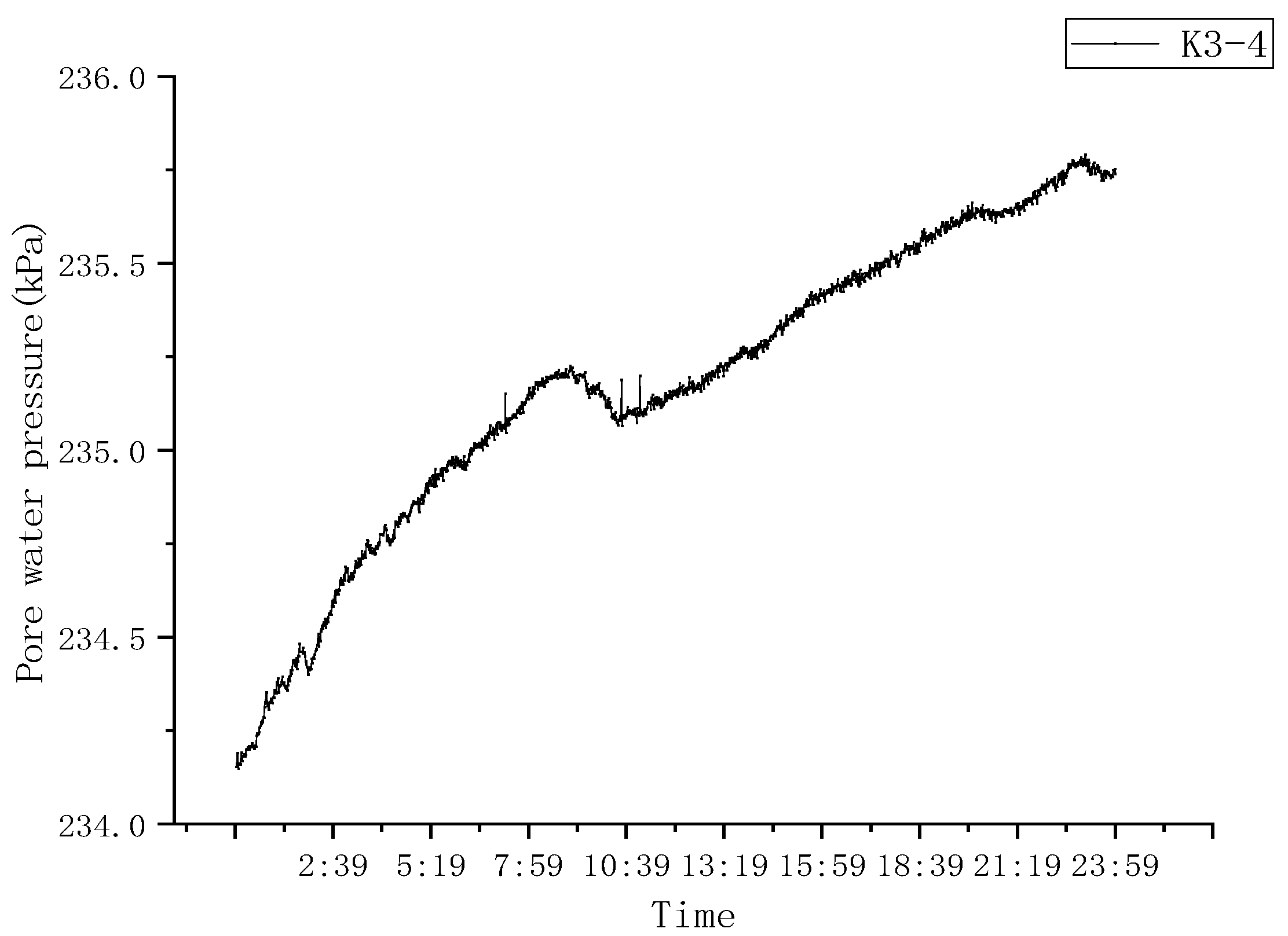
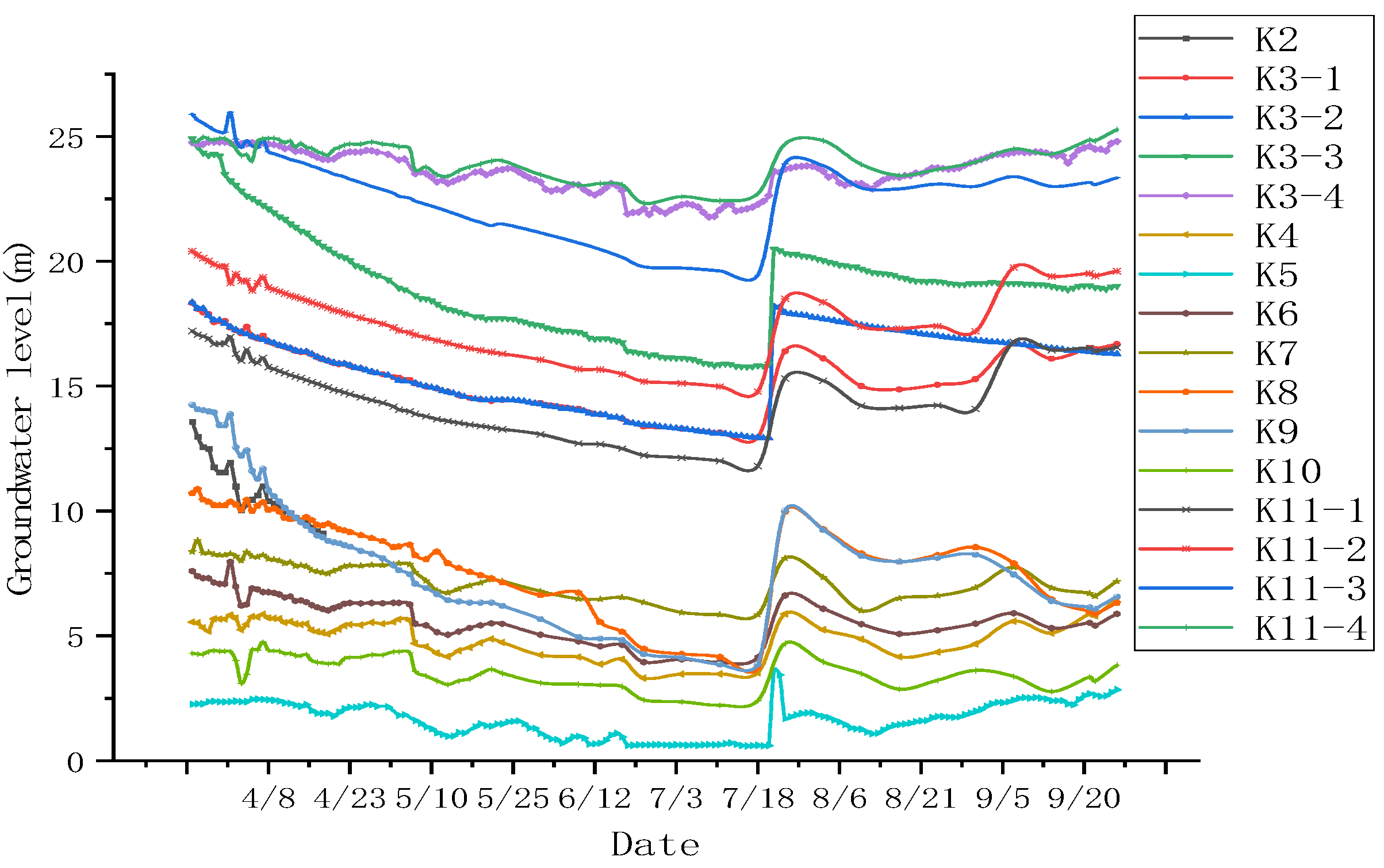

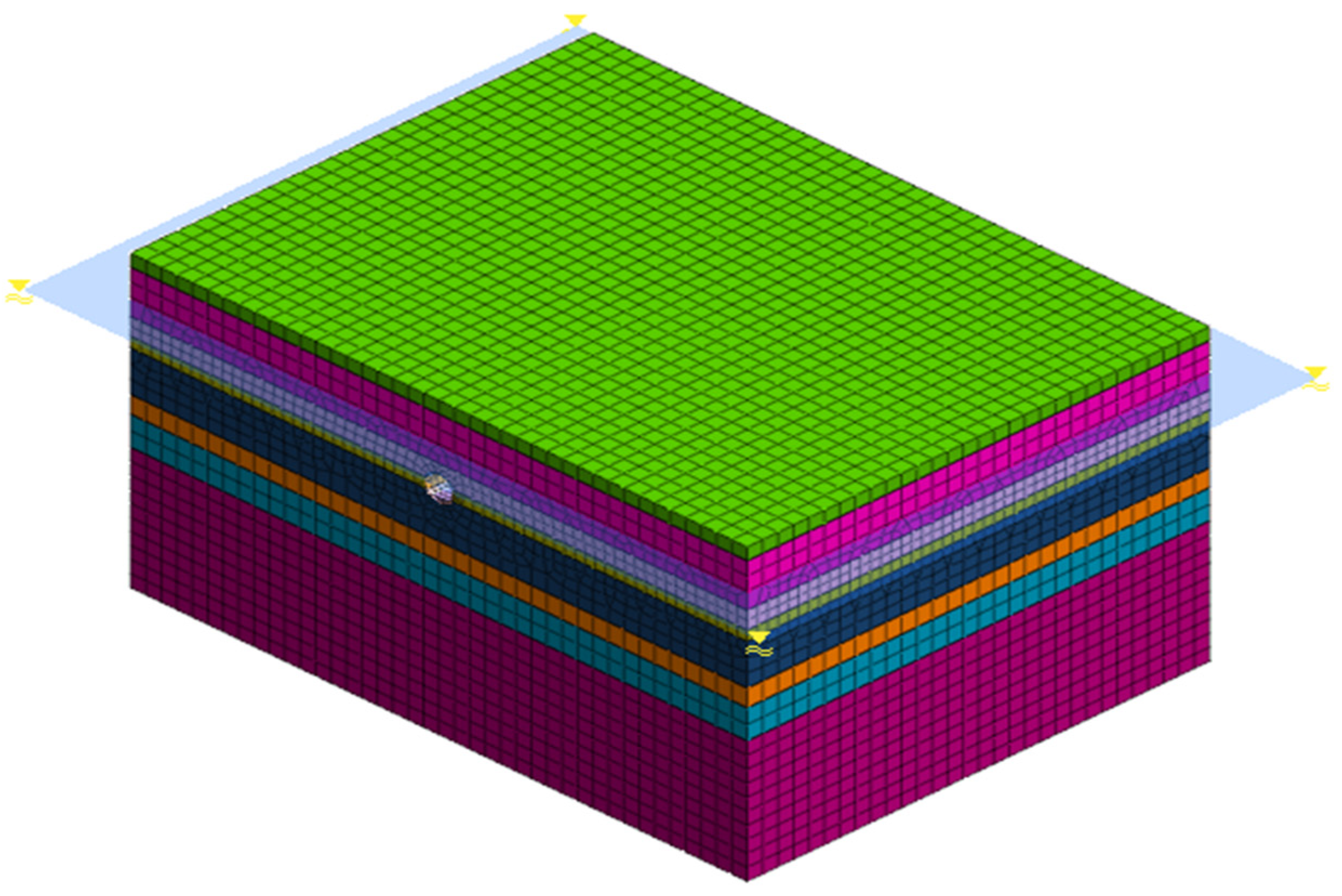
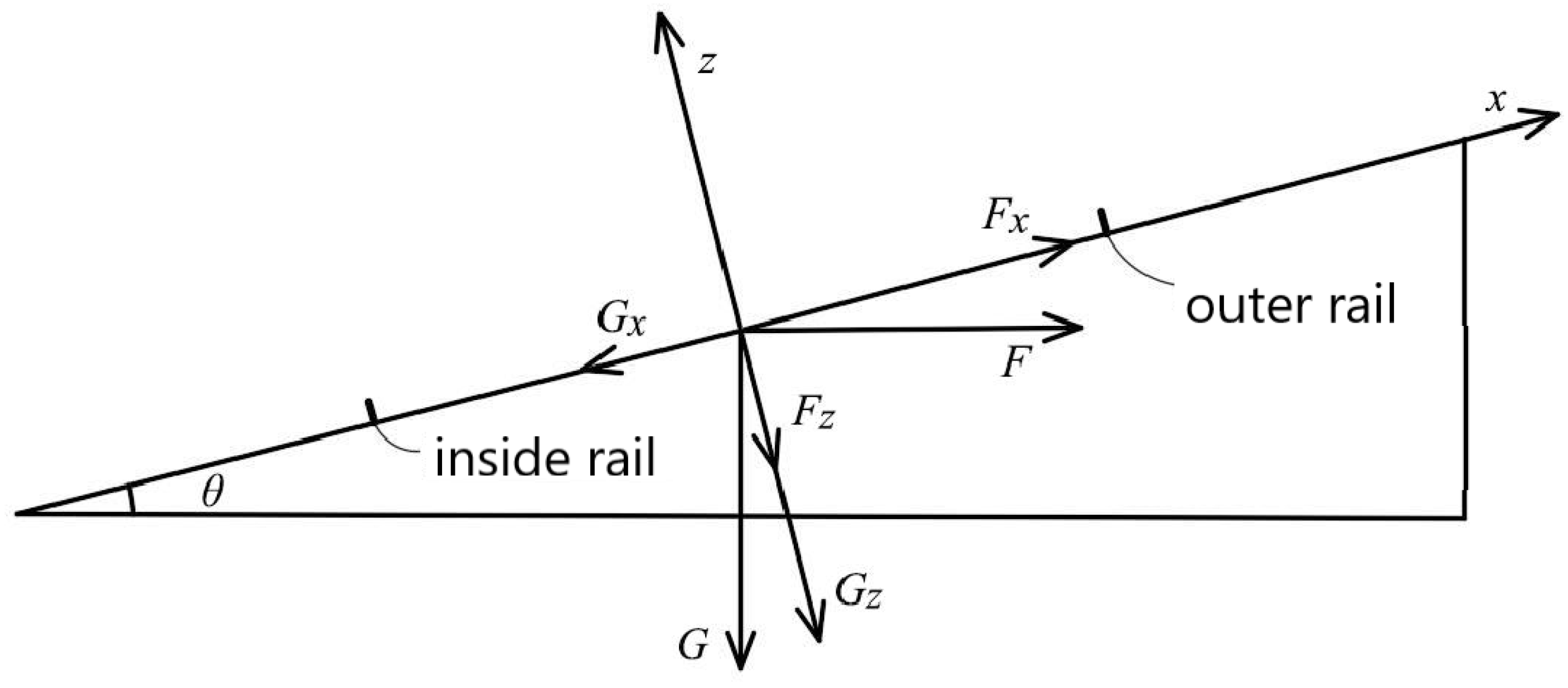


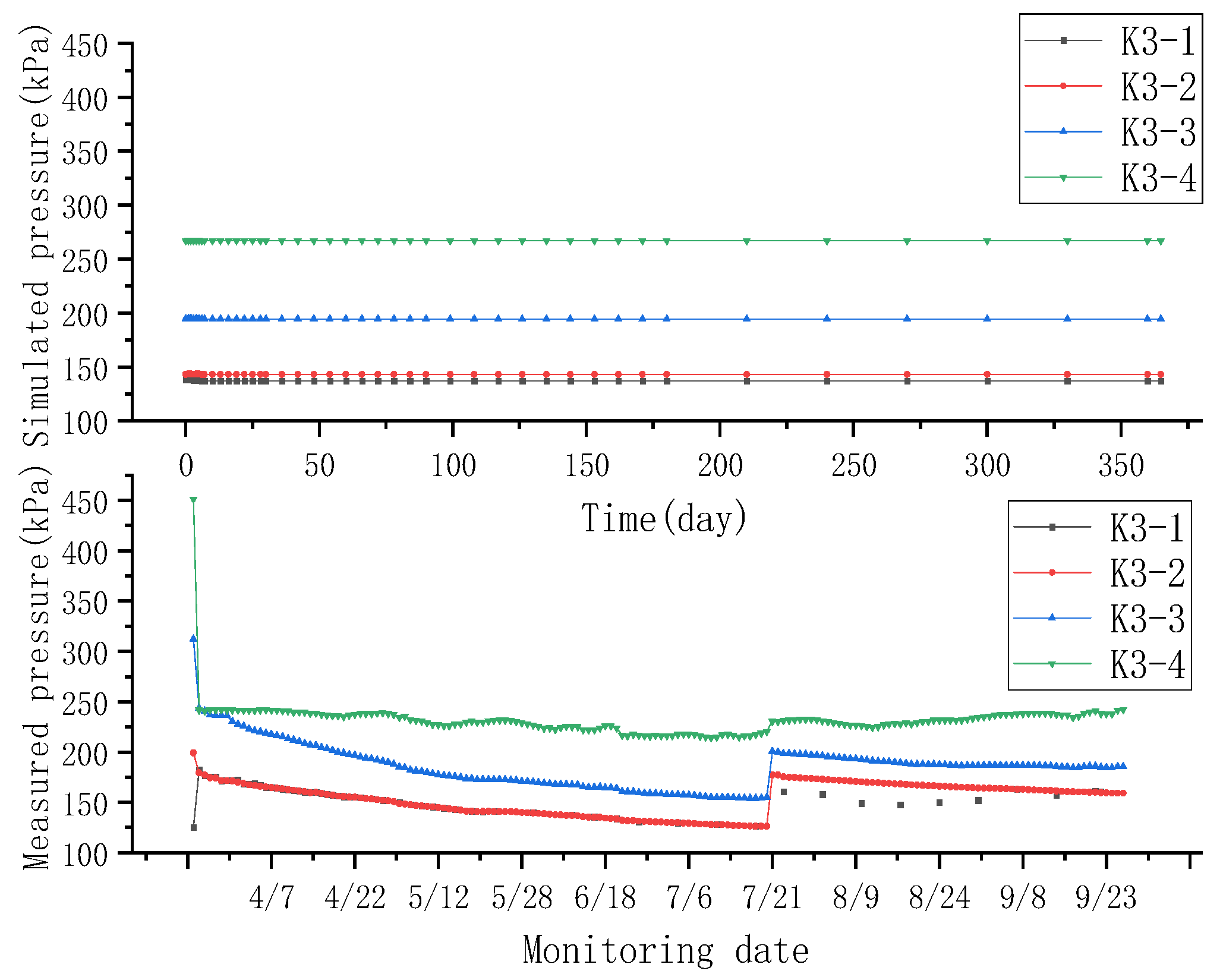
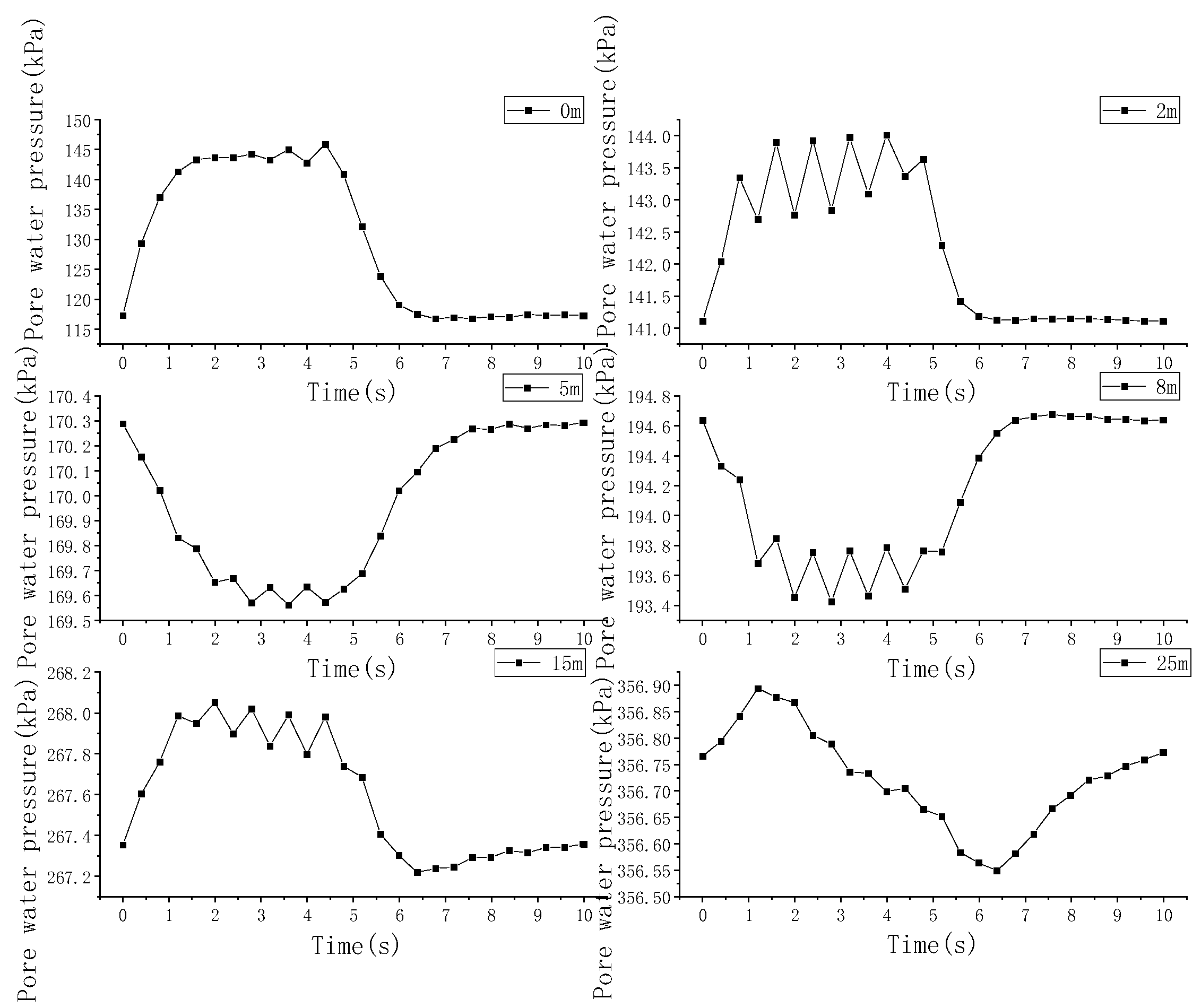
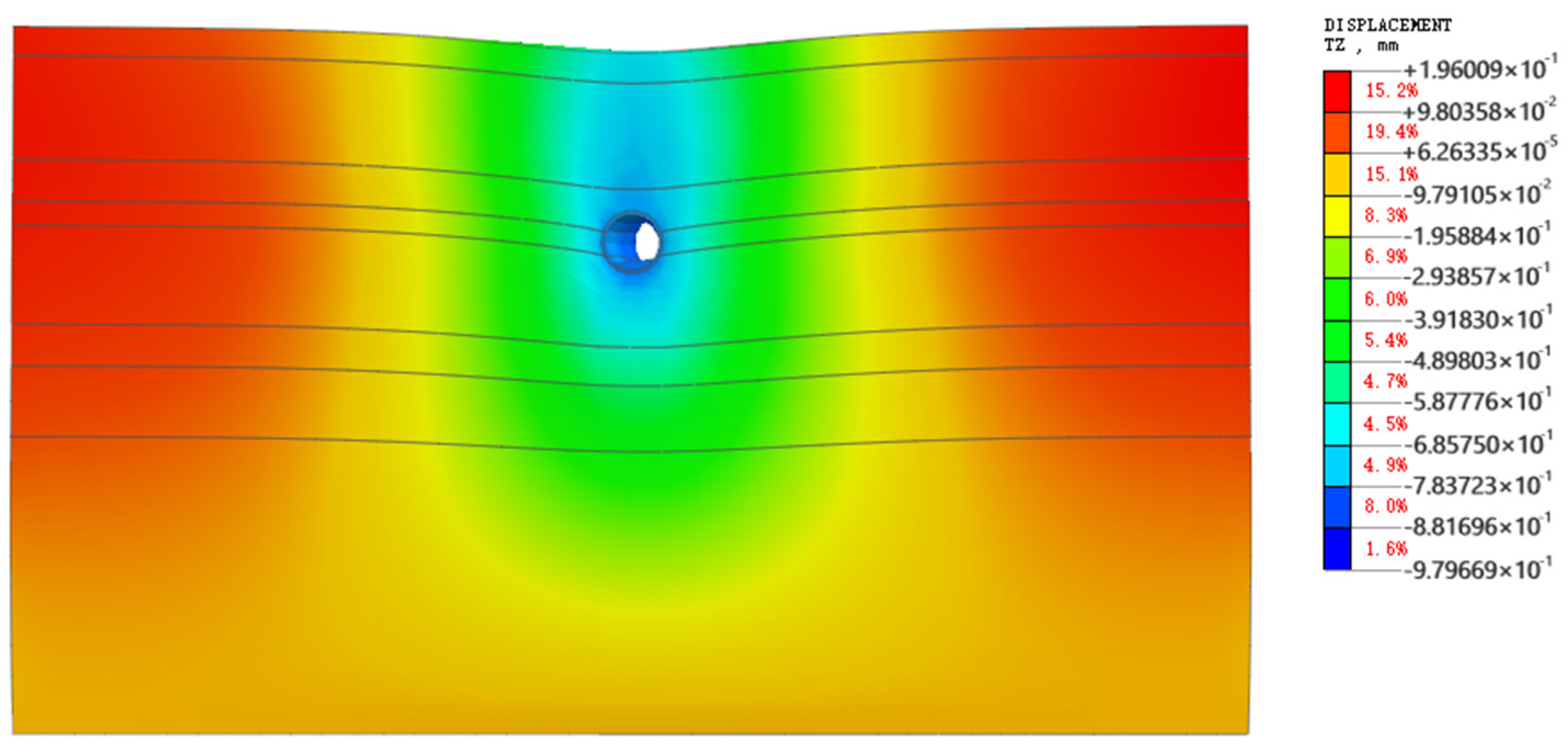
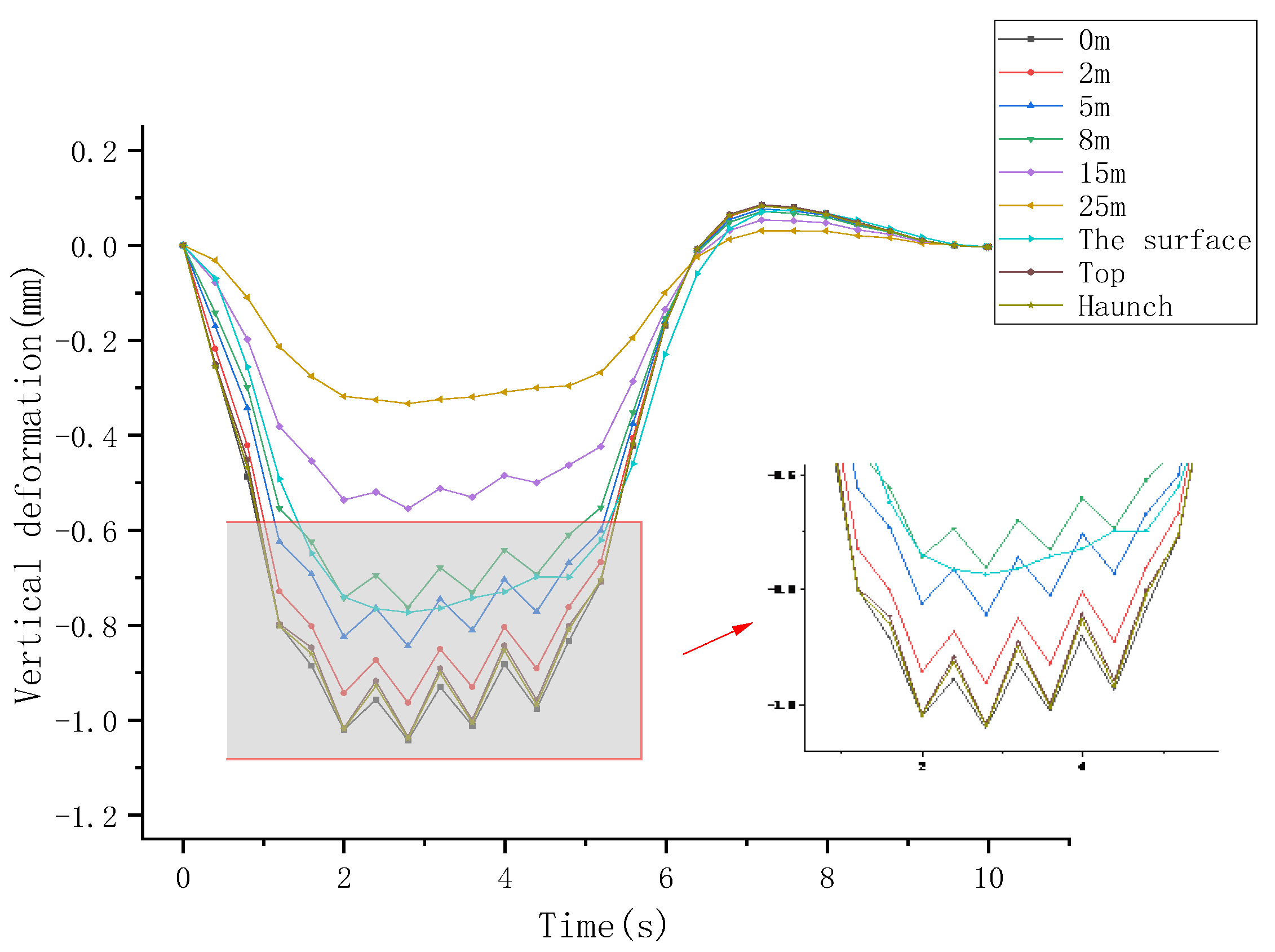



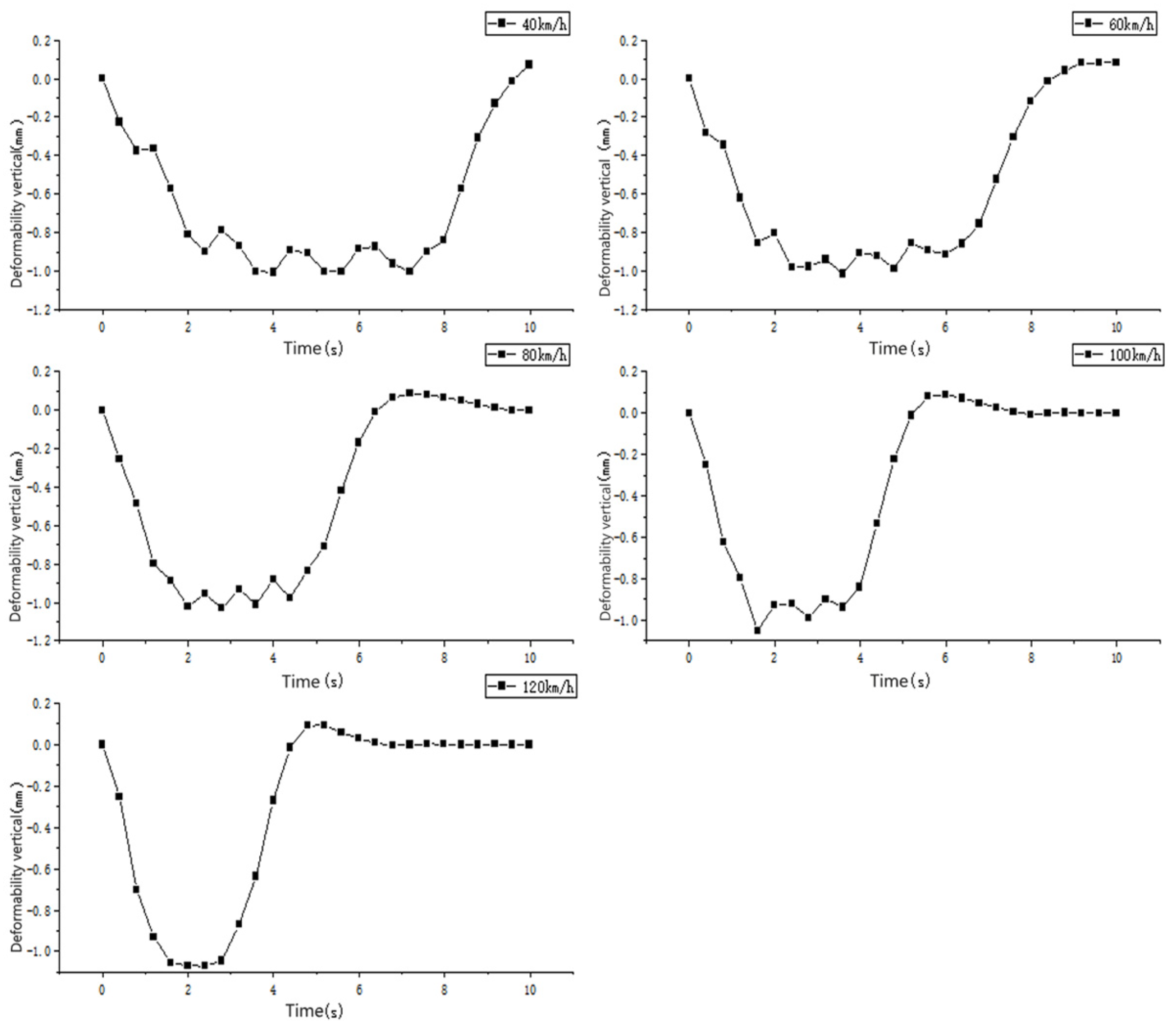
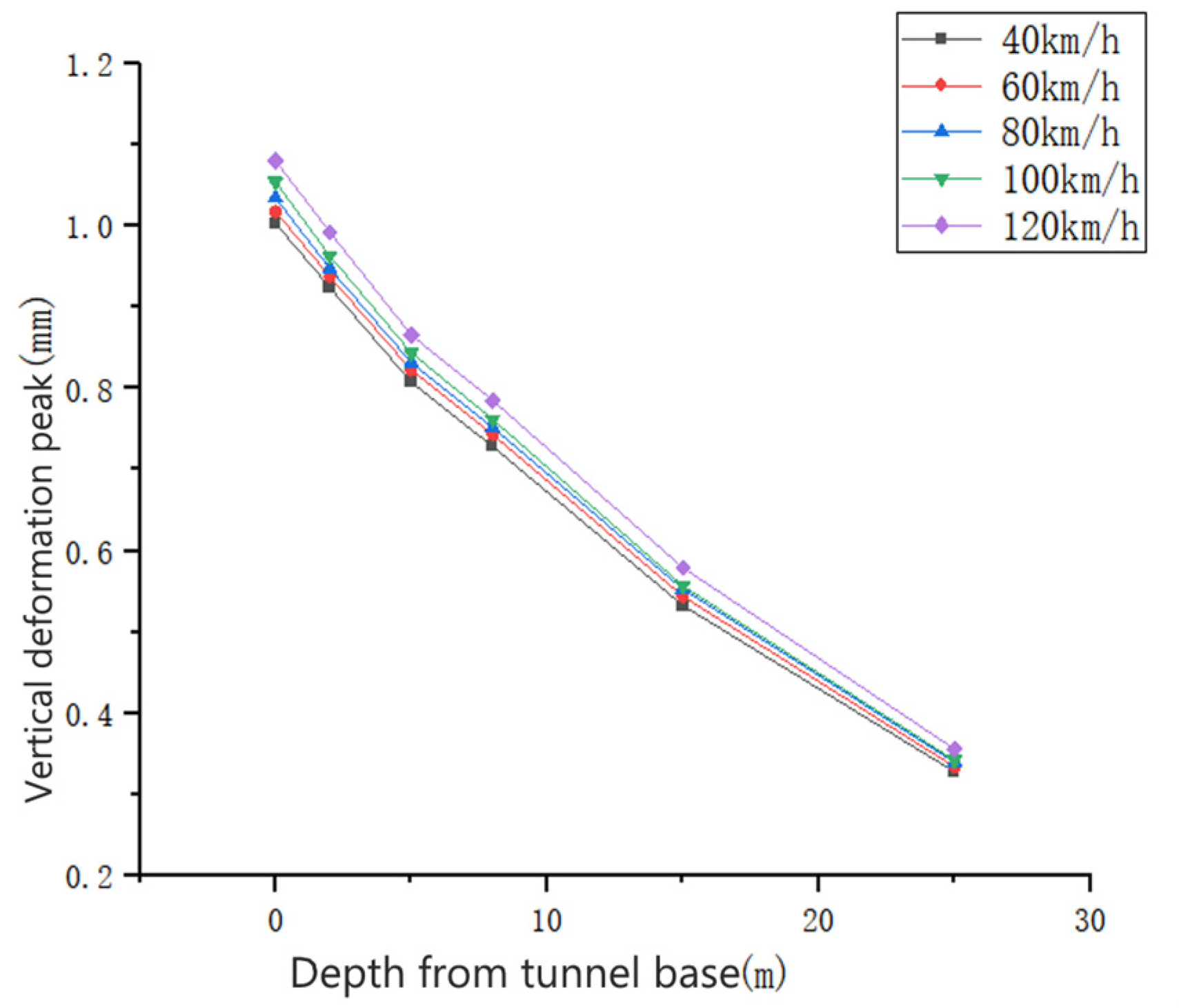
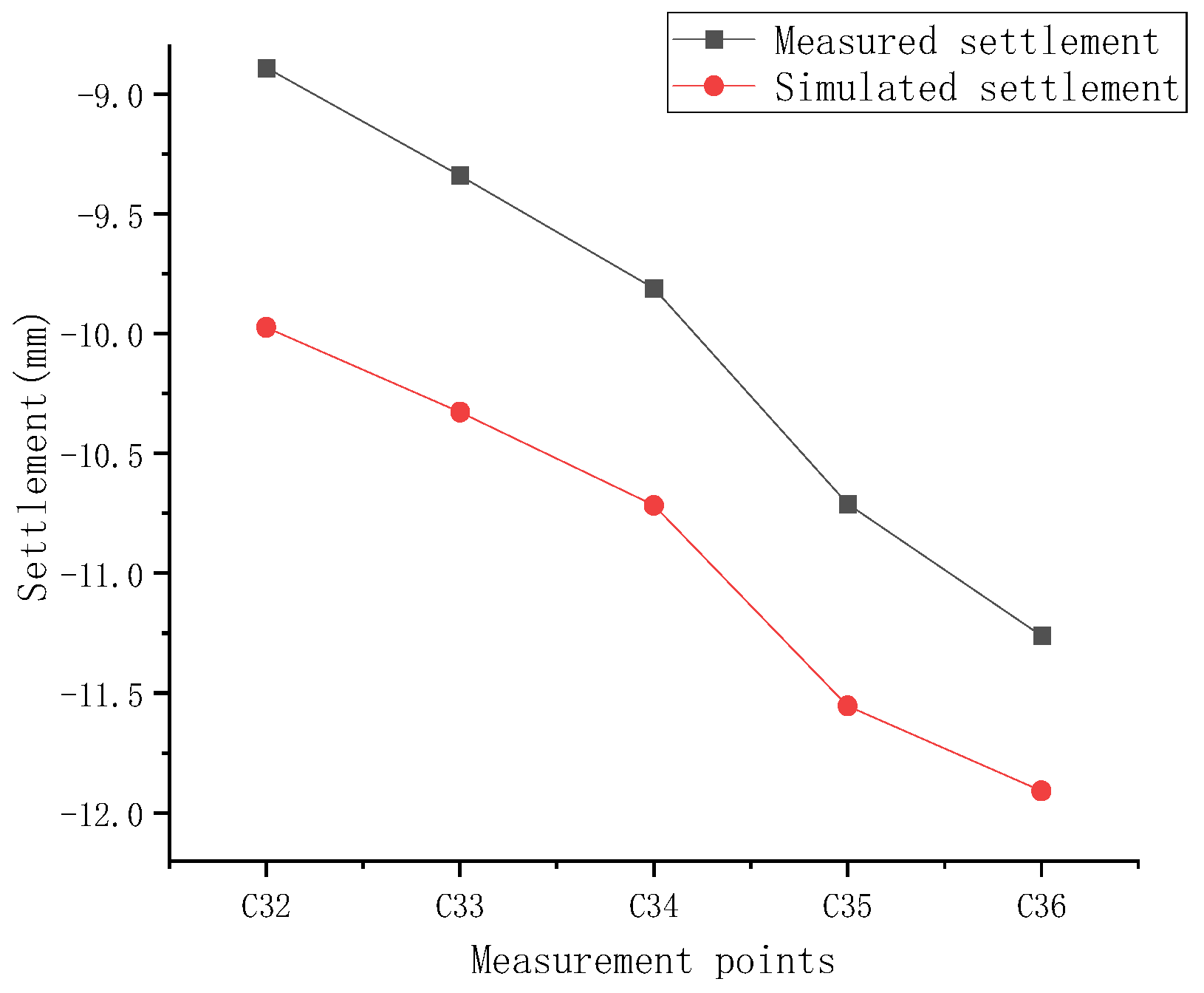
| Monitoring Point Number | Clear Distance between Monitoring Point and Tunnel Contour Plane/m | Monitoring Point Hole Depth/m | Distance between Hole Bottom and Tunnel Floor/m | Monitoring Equipment |
|---|---|---|---|---|
| K1 | 4.8 | 21.5 | 0.5 | Automatic |
| K2 | 3.6 | 21.5 | 0.9 | Artificial |
| K3-1 | 4.6 | 20.0 | 0.6 | Artificial |
| K3-2 | 4.6 | 23.0 | 3.6 | Automatic |
| K3-3 | 4.6 | 28.0 | 8.6 | Automatic |
| K3-4 | 4.6 | 38.0 | 18.6 | Automatic |
| K4 | 4.8 | 19.0 | 0.8 | Artificial |
| K5 | 3.3 | 18.0 | 0.8 | Automatic |
| K6 | 3.7 | 21.5 | 0.5 | Artificial |
| K7 | 3.9 | 21.5 | 0.9 | Artificial |
| K8 | 4.4 | 20.0 | 0.5 | Artificial |
| K9 | 3.8 | 19.0 | 0.6 | Artificial |
| K10 | 3.6 | 18.0 | 0.6 | Artificial |
| K11-1 | 4.0 | 20.0 | 0.5 | Artificial |
| K11-2 | 4.0 | 23.0 | 3.5 | Artificial |
| K11-3 | 4.0 | 28.0 | 8.5 | Artificial |
| K11-4 | 4.0 | 38.0 | 18.5 | Artificial |
| Name of Soil Layer | Layer Thickness/m | Modulus of Elasticity E/MPa | Poisson’s Ratio/µ | Heavy KN/M3 | Angle of Friction/° | Cohesion /KPa |
|---|---|---|---|---|---|---|
| Miscellaneous fill | 2.855 | 9 | 0.37 | 17 | 18 | 10 |
| Silt | 10.095 | 8.1 | 0.3 | 19.6 | 20 | 14 |
| Silty clay | 4.04 | 5.2 | 0.3 | 19.2 | 10 | 19 |
| Silty sand | 2.3475 | 12.63 | 0.3 | 20.2 | 24 | 0 |
| Medium sand | 9.51 | 34.58 | 0.25 | 20.8 | 31 | 0 |
| Silty clay | 4.0275 | 11.58 | 0.25 | 20 | 13 | 22 |
| Medium sand | 6.775 | 33.33 | 0.25 | 20.8 | 30 | 0 |
| Silty clay | 28.65 | 20.35 | 0.3 | 20.1 | 14 | 16 |
| Lining | 0.3 | 34.5 | 0.2 | 25 | / | / |
| Roadbed | 0.44 | 30 | 0.2 | 25 | / | / |
| Axle Load /t | Vehicle Speed km/h | Turning Radius /m | Vertical Load /kN | Lateral Load /kN |
|---|---|---|---|---|
| 13 | 80 | 250 | 128.82 | 12.66 |
| 80 | 350 | 128.62 | 7.61 | |
| 80 | 500 | 128.17 | −0.56 | |
| 80 | 700 | 127.79 | −4.21 | |
| 80 | 1000 | 127.50 | −6.94 | |
| 80 | straight line | 130 | / |
Disclaimer/Publisher’s Note: The statements, opinions and data contained in all publications are solely those of the individual author(s) and contributor(s) and not of MDPI and/or the editor(s). MDPI and/or the editor(s) disclaim responsibility for any injury to people or property resulting from any ideas, methods, instructions or products referred to in the content. |
© 2023 by the authors. Licensee MDPI, Basel, Switzerland. This article is an open access article distributed under the terms and conditions of the Creative Commons Attribution (CC BY) license (https://creativecommons.org/licenses/by/4.0/).
Share and Cite
Sun, L.; Zhao, J.; Qin, W.; Hou, D.; Wang, X. Dynamic Response Analysis of Soil around Curve Section Tunnel under Train Vibration Load. Appl. Sci. 2023, 13, 8013. https://doi.org/10.3390/app13148013
Sun L, Zhao J, Qin W, Hou D, Wang X. Dynamic Response Analysis of Soil around Curve Section Tunnel under Train Vibration Load. Applied Sciences. 2023; 13(14):8013. https://doi.org/10.3390/app13148013
Chicago/Turabian StyleSun, Liguang, Jiansheng Zhao, Wenqian Qin, Dazhao Hou, and Xiaorui Wang. 2023. "Dynamic Response Analysis of Soil around Curve Section Tunnel under Train Vibration Load" Applied Sciences 13, no. 14: 8013. https://doi.org/10.3390/app13148013




